| |
Family (Alpha): | |
| View | Gryllidae Members:
| NC Records |
|---|
Neonemobius variegatus (Bruner, 1893) - Variegated Ground Cricket |
| No image for this species. |
|
|
|
|
|
Image Gallery for Neonemobius variegatus - Variegated Ground Cricket
|
 | Recorded by: Steve Hall and Bruce Sorrie
Richmond Co.
Comment: 44 syllables per sec @ 7.9 kHz |  | Recorded by: Steve Hall
Richmond Co.
Comment: 33.2 pps at 6.8 kHz |
 | Recorded by: Steve Hall
Chatham Co.
Comment: Broken series of trills. Recorded along a rocky river shoreline |  | Recorded by: Steve Hall
Chatham Co.
Comment: 37 syllables per second @ 7.8 kHz; syllable shape unclear (recorded using an mp3 voice recorder) |
|
MP3 Gallery for Neonemobius variegatus - Variegated Ground Cricket
|
| 1 | Recorded by: Steve Hall
Chatham Co.
2024-07-21
37 syllables per second @ 7.8 kHz; syllable shape unclear (mp3 recording) |

 »
»


